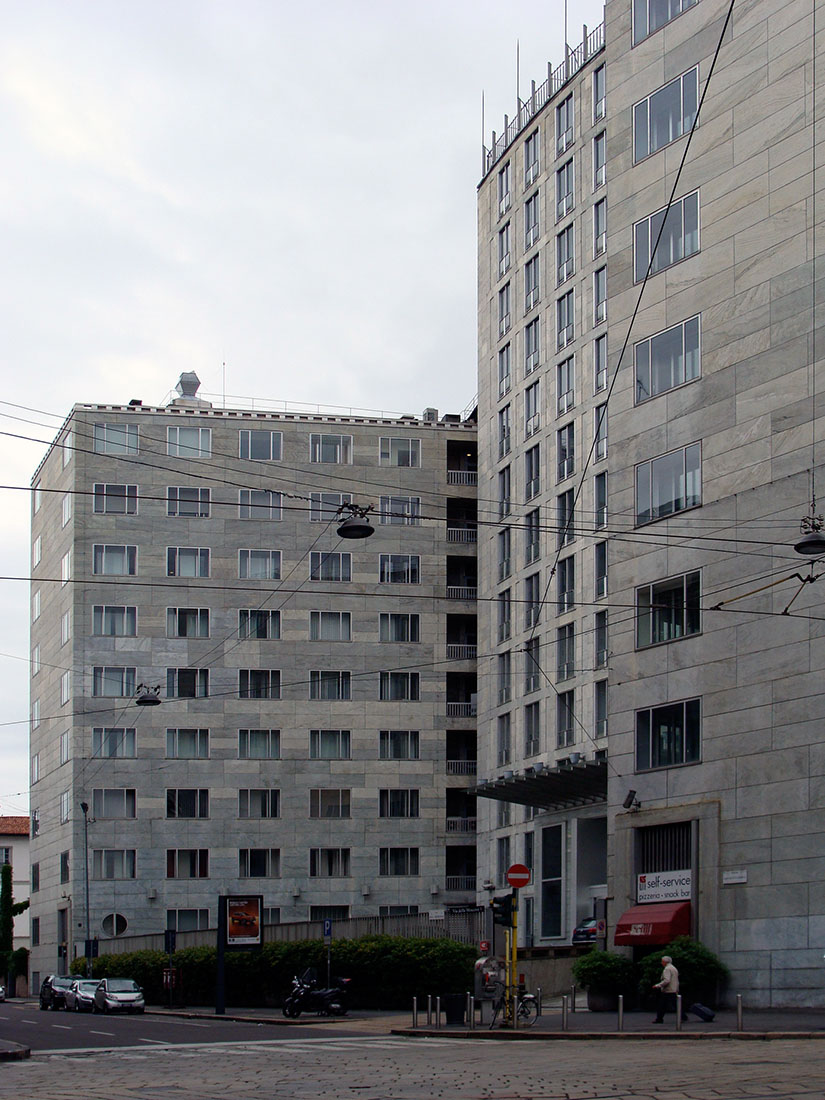 |
 |
 |
 |


Office Building Montecatini I, Milano
Via della Moscova / Via Filippo Turati
1936 - 1938
Gio Ponti realized his first major office building for the chemical company Montecatini. This building, located on Via della Moscova in Milan next to the famous Ca' Brütta
by Giovanni Muzio, provided space for around 1,500 workplaces. The building is divided into three parts, the middle part is intended for the executive staff.
In this section is also located the entrance, which is covered by a cantilevered steel and glass construction. The two laterally arranged volumes contain
the offices of the remaining employees. In the basement are housed a variety of recreational facilities and services, these include a lounge area, changing rooms
with showers, a library, a hairdressing salon, a photo studio, a bar, a pharmacy, a grocery store, a clothing boutique and a bazaar. A remarkable spatial situation
is created in the dining hall, which is separated from the kitchen only by a glass wall. This allows to watch the cooks at work. The building was equiped with 16 elevators,
three freight elevators and a pneumatic delivery system. A particular innovation in Italy at that time was the installation of an air conditioning system.
The façade of the building is characterized by long rows of windows which are repeated uniformly in the horizontal and vertical direction.
The whole concept and the design are both very functionally oriented, and it is this work by Gio Ponti, which is closest related to the rationalism.
At this time Gio Ponti had not yet developed his theory of the completed form (forma finita), which has been particularly applied in the Pirelli Tower.
Although Gio Ponti was quite enthusiastic about rhythmic structures, which can be endlessly extended and increased, he did not consider them to belong to
the category of artistic architecture. For him, these were more works of engineers, because he was of the opinion that engineering is progressive in contrast
to architecture. In this sense, the Montecatini office building by Gio Ponti is rather close to the engineering discipline. Nevertheless, this building was designed to
the last detail by the Studio Ponti-Fornaroli-Soncini. In choosing the materials Gio Ponti demonstrated his ingenious inventiveness. He induced cutting the Cipollino Rigato
marble against the grain and thus received a new type of marble, which he called "Tempesta".
After the side wings of the building had been damaged in a bombing raid during the Second World War, Guido Donegani heightend them by another floor. In this relation
he referred to the sheer functionality of this architecture. Gio Ponti, who took into account the volumetric proportions when designing the building, distanced himself
from this decision. He pulled his lesson from this experience, and from then on the preferred the completed form.
by Giovanni Muzio, provided space for around 1,500 workplaces. The building is divided into three parts, the middle part is intended for the executive staff.
In this section is also located the entrance, which is covered by a cantilevered steel and glass construction. The two laterally arranged volumes contain
the offices of the remaining employees. In the basement are housed a variety of recreational facilities and services, these include a lounge area, changing rooms
with showers, a library, a hairdressing salon, a photo studio, a bar, a pharmacy, a grocery store, a clothing boutique and a bazaar. A remarkable spatial situation
is created in the dining hall, which is separated from the kitchen only by a glass wall. This allows to watch the cooks at work. The building was equiped with 16 elevators,
three freight elevators and a pneumatic delivery system. A particular innovation in Italy at that time was the installation of an air conditioning system.
The façade of the building is characterized by long rows of windows which are repeated uniformly in the horizontal and vertical direction.
The whole concept and the design are both very functionally oriented, and it is this work by Gio Ponti, which is closest related to the rationalism.
At this time Gio Ponti had not yet developed his theory of the completed form (forma finita), which has been particularly applied in the Pirelli Tower.
Although Gio Ponti was quite enthusiastic about rhythmic structures, which can be endlessly extended and increased, he did not consider them to belong to
the category of artistic architecture. For him, these were more works of engineers, because he was of the opinion that engineering is progressive in contrast
to architecture. In this sense, the Montecatini office building by Gio Ponti is rather close to the engineering discipline. Nevertheless, this building was designed to
the last detail by the Studio Ponti-Fornaroli-Soncini. In choosing the materials Gio Ponti demonstrated his ingenious inventiveness. He induced cutting the Cipollino Rigato
marble against the grain and thus received a new type of marble, which he called "Tempesta".
After the side wings of the building had been damaged in a bombing raid during the Second World War, Guido Donegani heightend them by another floor. In this relation
he referred to the sheer functionality of this architecture. Gio Ponti, who took into account the volumetric proportions when designing the building, distanced himself
from this decision. He pulled his lesson from this experience, and from then on the preferred the completed form.